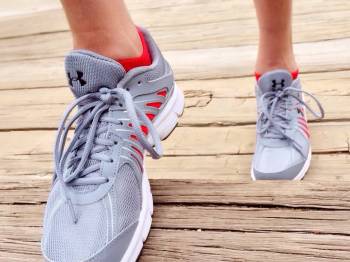High-Intensity Interval Training
 High-intensity interval training, or HIIT for short, is becoming increasing popular. It basically involves repeated bouts of high intensity exercise, followed by a period of recovery.
High-intensity interval training, or HIIT for short, is becoming increasing popular. It basically involves repeated bouts of high intensity exercise, followed by a period of recovery.
This intense work periods may range for as short as 5 seconds to as long as 8 minutes, and are performed at 80% to 95% of a person’s estimated maximal heart rate. The recovery periods may last as long as the work periods, or longer depending on ones fitness level. This work-rest cycle repeats for a total of 20 to 60 minutes.
What are the benefits of HIIT?
A recent study compared individuals who did steady-state cardio for 30 minutes three times a week, with those who did 20 minutes of high-intensity interval training (HIIT) three times per week.
Both groups showed similar weight loss, but the HIIT group showed a 2% loss in body fat while the steady-state group lost only 0.3%. The HIIT group also gained nearly two pounds of muscle, while the steady-state group lost almost a pound.
HIIT training has also been shown to improve:
• aerobic and anaerobic fitness
• blood pressure
• cardiovascular health
• insulin sensitivity (which helps the exercising muscles more readily use glucose for fuel to make energy)
• cholesterol profiles
• abdominal fat and body weight while maintaining muscle mass.
What's all the fuss about HIIT?
Izumi Tabata, a Japanese researcher who has conducted extensive research on interval training, came up with the exercise program bearing his name "Tabata", which consists of performing an intense activity all-out for 20 seconds, resting for 10 seconds, and then repeating the sequence for a total of 4 minutes.
One of Tabata's most famous findings demonstrated that 20 seconds of all-out cycling followed by 10 seconds of low intensity cycling for four minutes was as beneficial for maximal aerobic capacity as 45 minutes of long, slow cardio performed four times per week.
It conclusively showed that positive health benefits derived from traditional aerobic training, could be accomplished in a much shorter time with high-intensity interval training.
How this works is because HIIT workouts tend to burn more calories than traditional workouts, especially after the workout. For about 2 hours after exercise, the body uses energy to restore itself to pre-exercise levels. This post-exercise period is called "EPOC", which stands for Excess Post-exercise Oxygen Consumption. Because of the vigorous contractile nature of HIIT workouts, the EPOC generally tends to be modestly greater, adding about 6 to 15% more calories to the overall workout energy expenditure.
How do You Develop a HIIT Exercise Program?
HIIT training can be easily modified for people of all fitness levels and conditions, such as for those who may be overweight, hypertensive or diabetic. HIIT workouts can be performed in a variety of ways: cycling, walking, swimming, aqua training, elliptical cross-training, and in many group exercise classes.
When developing a HIIT programme, consider the duration and intensity of the work intervals and the length of the recovery periods.
INTENSITY: Intensity during the high intensity work interval should bring you to ≥ 80% of your estimated maximal heart rate. The intensity of the recovery interval should be 40-50% of your estimate maximal heart rate.
WORK-RECOVERY RATIO: The relationship of the work and recovery interval is also important. For example, a ratio of 1:1 might be a 3-minute high intensity bout, followed by a 3-minute recovery. These 1:1 interval workouts often range about 3, 4, or 5 minutes followed by an equal time in recovery. Another popular HIIT protocol is called the “spring interval training method”. Here you would do about 30 seconds of ‘sprint or near all-out effort’, which is followed by 4 to 4.5 minutes of recovery. So if you do a 30 second sprint or rapid skip/cycle, followed by a 4.5 minute recovery, each sequence will take 5 minutes. This combination of exercise can be repeated 3 to 5 times.
Is it safe?
Because of the nature of HIIT, which demands sudden high level energy expenditure, ensuring the absence of coronary heart disease is of paramount importance. Family history of coronary heart disease, cigarette smoking, hypertension, diabetes, abnormal cholesterol levels and obesity will increase the risk of coronary heart disease. If you have any of the listed risk factors, getting medical clearance from your doctor before you start on HIIT would be a good idea.
One of the keys to safe participation in HIIT, regardless of age and fitness level, is to modify the intensity and work-recovery ratio to a level which is sufficiently challenging. Keeping safety the top priority, people should focus more on finding their own optimal training intensities as opposed to keeping up with others.
How often should I do a HIIT workout?
HIIT workouts are tend to be a lot more exhaustive then steady state endurance workouts. Therefore, a longer recovery period is often needed.
Start by adding one HITT workout to your steady state workout in a week. As your fitness level improves, and a second HIIT workout a week, ensuring that you have enough of a rest period in between.
The incorporation of interval training into a general conditioning program will help optimize cardiorespiratory fitness and help you burn off more calories as well as build muscle mass. Try it!
Further Reading
The article above is meant to provide general information and does not replace a doctor's consultation.
Please see your doctor for professional advice.
